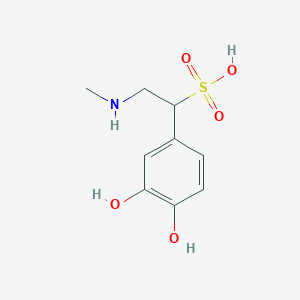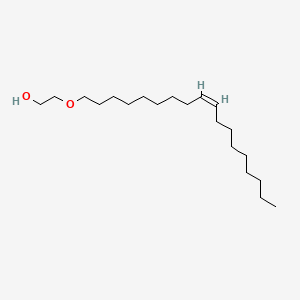
Acarbose
- Click on QUICK INQUIRY to receive a quote from our team of experts.
- With the quality product at a COMPETITIVE price, you can focus more on your research.
Overview
Description
Acarbose is a complex oligosaccharide that acts as an inhibitor of several enzymes responsible for the breakdown of complex carbohydrates in the intestines. It is primarily used as an anti-diabetic drug to manage type 2 diabetes mellitus by controlling postprandial blood glucose levels. This compound works by inhibiting alpha-glucosidase, an intestinal enzyme that releases glucose from larger carbohydrates such as starch and sucrose .
Preparation Methods
Synthetic Routes and Reaction Conditions: Acarbose is produced through a fermentation process involving the bacterium Actinoplanes sp. The biosynthesis involves the formation of acarviosin, which is then linked to maltose. The fermentation process is optimized by controlling the osmolality of the fermentation solution, which significantly affects the yield of this compound .
Industrial Production Methods: Industrial production of this compound involves large-scale fermentation using optimized conditions to maximize yield. The process includes the use of specific carbon sources, such as a mixture of maltose and glucose, to enhance the biosynthesis of this compound. The fermentation is carried out in bioreactors with controlled parameters such as temperature, pH, and oxygen supply .
Chemical Reactions Analysis
Types of Reactions: Acarbose undergoes various chemical reactions, including hydrolysis and enzymatic degradation. It is primarily involved in inhibition reactions where it binds to alpha-glucosidase enzymes, preventing the breakdown of complex carbohydrates .
Common Reagents and Conditions: The common reagents used in the reactions involving this compound include alpha-glucosidase enzymes and substrates such as maltose and sucrose. The reactions typically occur under physiological conditions in the gastrointestinal tract .
Major Products Formed: The major products formed from the reactions involving this compound are glucose and other simple sugars, which are released from the breakdown of complex carbohydrates .
Scientific Research Applications
Diabetes Management
Acarbose is widely recognized for its effectiveness in controlling blood glucose levels in patients with type 2 diabetes. Clinical studies have demonstrated significant improvements in glycemic control when this compound is used as part of a treatment regimen.
- Efficacy : A study involving 1,946 patients showed that this compound significantly improved glycemic control over three years, achieving a median reduction in HbA1c of 0.5% compared to placebo (8.1% vs. 8.6%) .
- Combination Therapy : this compound has been shown to be effective irrespective of other diabetes medications, including insulin and metformin .
Cardiovascular Disease Prevention
Recent research indicates that this compound may play a protective role against cardiovascular disease (CVD) in diabetic patients.
- Risk Reduction : A study over ten years found that patients receiving this compound therapy had a significantly lower incidence of myocardial infarction (1.78% vs. 3.57%) and all-cause mortality (6.16% vs. 11.61%) compared to those not treated with this compound .
- Hypertension Prevention : Another study reported a relative risk reduction of 34% for developing hypertension among patients treated with this compound .
Anti-Inflammatory Effects
Emerging evidence suggests that this compound may have anti-inflammatory properties, potentially reducing the risk of inflammatory diseases such as rheumatoid arthritis.
- Rheumatoid Arthritis Risk : A population-based study indicated that high usage of this compound was associated with a lower risk of developing rheumatoid arthritis among diabetic patients, with an odds ratio of 0.60 .
- Mechanism : The anti-inflammatory effects may stem from this compound's ability to modulate immune responses and reduce inflammatory markers in the bloodstream .
Adverse Effects and Compliance
Despite its benefits, the use of this compound is often limited by gastrointestinal side effects, which can affect patient compliance.
- Common Side Effects : Patients frequently report flatulence, diarrhea, and abdominal pain, leading to a higher discontinuation rate among those taking this compound compared to placebo groups .
- Management Strategies : Careful titration and patient education on potential side effects are essential for improving adherence to therapy .
Summary Table of this compound Applications
Mechanism of Action
Acarbose exerts its effects by inhibiting alpha-glucosidase enzymes located in the brush-border of the intestinal mucosa. These enzymes are responsible for metabolizing oligo-, tri-, and disaccharides into absorbable simple sugars. By inhibiting these enzymes, this compound limits the absorption of dietary carbohydrates and reduces the postprandial increase in blood glucose and insulin levels . The inhibition is competitive and reversible, and this compound mimics the transition state of the substrate with its amine linkage .
Comparison with Similar Compounds
Voglibose: Another alpha-glucosidase inhibitor used to manage postprandial blood glucose levels in diabetic patients.
Miglitol: An alpha-glucosidase inhibitor that is structurally different from acarbose and voglibose.
Uniqueness of this compound: this compound is unique due to its complex oligosaccharide structure and its ability to inhibit multiple enzymes involved in carbohydrate metabolism. It has been shown to be effective in reducing postprandial blood glucose levels and improving cardiovascular outcomes in diabetic patients .
Q & A
Basic Research Questions
Q. What are the primary mechanisms of action of Acarbose in glycemic control, and how are these mechanisms experimentally validated?
this compound inhibits intestinal α-glucosidase enzymes, delaying carbohydrate digestion and reducing postprandial hyperglycemia. Methodologically, this is validated via in vitro enzyme assays (e.g., PNPG substrate hydrolysis) and kinetic analyses (Lineweaver-Burk plots) to determine inhibition type (competitive/mixed) . Clinical trials corroborate this by measuring postprandial glucose reduction (e.g., 1.63–3.62 mmol/L decrease with 50–300 mg doses) .
Q. What experimental designs are standard for evaluating this compound efficacy in clinical trials?
Randomized, double-blind, placebo-controlled trials (RCTs) with impaired glucose tolerance (IGT) or type 2 diabetes (T2D) cohorts are standard. Key endpoints include:
- Primary : Glycated hemoglobin (HbA1c) reduction, diabetes incidence .
- Secondary : Postprandial glucose, cardiovascular events, hypertension . The STOP-NIDDM trial (n=1,368, 3.3-year follow-up) exemplifies this design, using intent-to-treat analysis and hazard ratios for risk reduction .
Q. How is this compound dosage optimized in pharmacological studies, and what are common dose-response relationships?
Dosage optimization involves titration (e.g., 50–300 mg t.i.d.) with incremental HbA1c reductions. A meta-analysis showed dose-dependent postprandial glucose lowering (1.63 mmol/L at 50 mg vs. 3.62 mmol/L at 300 mg) . Trials often use 100 mg t.i.d. for balancing efficacy and gastrointestinal tolerability .
Q. What quality control methods ensure this compound purity in pharmaceutical research?
Pharmacopeial standards include:
- Purity : HPLC with UV detection, comparing peak areas of related substances (e.g., ≤0.5% impurities) .
- Residual solvents : Heavy metal testing via atomic absorption spectroscopy (≤10 ppm lead) .
Advanced Research Questions
Q. How do molecular docking studies resolve contradictions in this compound’s inhibition type (competitive vs. mixed)?
Discrepancies arise from methodological differences: in silico docking often predicts competitive inhibition by binding active sites, while in vitro kinetics (e.g., Hanes-Wolff plots) may suggest mixed inhibition due to allosteric effects. Multi-method validation (e.g., Eisenthal-Cornish-Bowden plots) is critical .
Q. What molecular pathways beyond α-glucosidase inhibition contribute to this compound’s metabolic effects?
this compound upregulates miR-10a-5p and miR-664 in the ileum, suppressing proinflammatory cytokines (e.g., TNF-α) via MAPK pathways. This is validated through miRNA sequencing and Western blotting in diabetic rat models .
Q. How do researchers address conflicting data on this compound’s cardiovascular benefits across meta-analyses and RCTs?
The MERIA meta-analysis (7 RCTs) reported cardiovascular risk reduction (HR 0.65), while individual trials like STOP-NIDDM showed 49% risk reduction. Heterogeneity arises from population differences (e.g., baseline HbA1c, IGT vs. T2D) and endpoint definitions (e.g., composite vs. individual events) . Sensitivity analyses and subgroup stratification (e.g., HbA1c ≥7%) mitigate these issues .
Q. What advanced analytical techniques quantify this compound’s pharmacokinetics and pharmacodynamics?
- Pharmacokinetics : LC-MS/MS for plasma concentration profiling, focusing on low bioavailability (<2%) due to minimal systemic absorption .
- Pharmacodynamics : Continuous glucose monitoring (CGM) to track postprandial fluctuations, combined with mechanistic modeling (e.g., HOMA-IR for insulin resistance) .
Q. How is this compound integrated into combination therapy regimens, and what methodological considerations apply?
In metformin-insufficient T2D patients, add-on this compound (100 mg b.i.d.) reduced HbA1c by 1.02% (P=0.0001) in a 24-week RCT. Key considerations include:
- Titration : Gradual dose escalation to minimize GI adverse events.
- Endpoint selection : Composite metrics (e.g., HbA1c + fasting glucose) for holistic efficacy assessment .
Q. What surrogate markers validate this compound’s long-term cardioprotective effects in preclinical studies?
Carotid intima-media thickness (CIMT) is a key surrogate; in STOP-NIDDM, this compound reduced CIMT progression by 50% (0.02 mm vs. 0.05 mm in placebo, P=0.027) via postprandial glucose modulation .
Q. Methodological Tables
Table 1: Dose-Dependent Efficacy of this compound in Postprandial Glucose Reduction
| Dose (mg t.i.d.) | Postprandial Glucose Reduction (mmol/L) | Study Design | Reference |
|---|---|---|---|
| 50 | 1.63 | RCT | |
| 100 | 2.26 | Meta-analysis | |
| 300 | 3.62 | RCT |
Table 2: Key Outcomes from the STOP-NIDDM Trial
| Outcome | Hazard Ratio (95% CI) | Absolute Risk Reduction | Reference |
|---|---|---|---|
| Cardiovascular Events | 0.51 (0.28–0.95) | 2.5% | |
| Hypertension | 0.66 (0.49–0.89) | 5.3% | |
| Diabetes Incidence | 0.75 (0.63–0.90) | 8.4% |
Properties
CAS No. |
56810-94-0 |
|---|---|
Molecular Formula |
C25H43NO18 |
Molecular Weight |
645.6 |
Origin of Product |
United States |
Disclaimer and Information on In-Vitro Research Products
Please be aware that all articles and product information presented on BenchChem are intended solely for informational purposes. The products available for purchase on BenchChem are specifically designed for in-vitro studies, which are conducted outside of living organisms. In-vitro studies, derived from the Latin term "in glass," involve experiments performed in controlled laboratory settings using cells or tissues. It is important to note that these products are not categorized as medicines or drugs, and they have not received approval from the FDA for the prevention, treatment, or cure of any medical condition, ailment, or disease. We must emphasize that any form of bodily introduction of these products into humans or animals is strictly prohibited by law. It is essential to adhere to these guidelines to ensure compliance with legal and ethical standards in research and experimentation.














